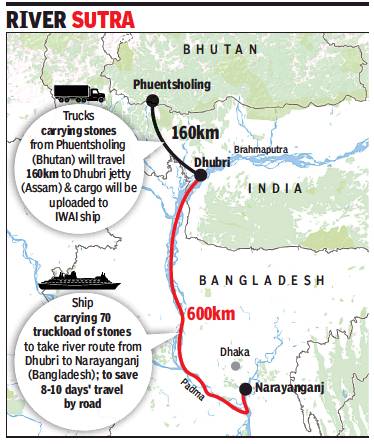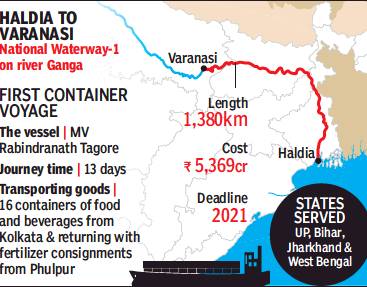Inland water transport: India
This is a collection of articles archived for the excellence of their content. |
Contents |
The Inland Waterways Authority of India (IWAI)
The Inland Waterways Authority of India (IWAI)
The Inland Waterways Authority of India (IWAI) came into existence on 27th October 1986 for development and regulation of inland waterways for shipping and navigation. The Authority primarily undertakes projects for development and maintenance of IWT infrastructure on national waterways through grant received from Ministry of Shipping. The head office of the Authority is at Noida. The Authority also has its regional offices at Patna, Kolkata, Guwahati and Kochi and sub-offices at Allahabad, Varanasi, Bhaglapur, Farakka, Hemnagar, Dibrugarh (Assam), Kollam, Bhubaneswar (Odisa) and Vijaywada (A.P.)
India has about 14,500 km of navigable waterways which comprise of rivers, canals, backwaters, creeks, etc. About 55 million tones of cargo is being moved annually by Inland Water Transport (IWT), a fuel - efficient and environment -friendly mode. Its operations are currently restricted to a few stretches in the Ganga-Bhagirathi-Hooghly rivers , the Brahmaputra, the Barak river, the rivers in Goa, the backwaters in Kerala, inland waters in Mumbai and the deltaic regions of the Godavari - Krishna rivers. Besides these organized operations by mechanized vessels, country boats of various capacities also operate in various rivers and canals. and substantial quantum of cargo and passengers are transported in this unorganized sector as well.
Brahmaputra
Dhubri to Bangladesh, for Bhutanese goods/ 2019
Dipak Dash, July 13, 2019: The Times of India

From: Dipak Dash, July 13, 2019: The Times of India
Now it will be easier and cheaper for Bangladesh to get construction material like stone chips from land-locked Bhutan after India opened its river route (Brahmaputra) to transport raw materials between the two countries.
The first ship carrying nearly 70 truckload of crushed stones from Bhutan started its journey from Dhubri riverport in Assam to Narayanganj in Bangladesh on Friday. “This is the first time an Indian waterway is being used as a channel for transport of cargo between two countries, using India for transit,” shipping minister Mansukh Mandaviya said while flagging off the ship.
Inland Waterways Authority of India (IWAI) chairman Pravir Pandey said the stone aggregates were transported by trucks from Phuentshiling in Bhutan which is 160 km from IWAI’s Dhubri jetty in Assam. The ship will cover 600 km in six days to reach Narayanganj, he said.
Bangladesh has been getting construction material from Bhutan by road. Till now, Bhutanese trucks carrying construction material would stop at Bangladesh border and the material had to be shifted to Bangladeshi trucks. Sometimes, it would take days to shift material at the international border. “Transporting construction material through waterway will help save about 10 days and transportation cost is likely to be 30% less. So, there will be operation of vessels to transport this cargo,” said an official.
IWAI, which is responsible for developing and maintaining national waterways, has carried out dredging on Brahmaputra to maintain an assured draft in navigation channel. Brahmaputra has been declared as NW-2.
INLAND WATER TRANSPORT
India has over 145000 km of navigable waterways. Considering the inherent advantages of Inland Water Transport (IWT) mode namely; fuel efficiency, environment friendliness, cost effectiveness and decongestion of road and rail networks, particularly for movement to bulk goods, hazardous good and over dimensional approach. Inland waterways Authority of India (IWAI) was set up in 1986 for regulation and development of inland waterways for the purpose of shipping and navigation. IWAI is primarily responsible for development, maintenance and regulation of national waterways. Following five waterways have so far been declared as national waterways:-
l Allahabad - Haldia stretch (1620km) of the Ganga-Bhagirathi-Hooghly river system (NW-1) in 1986.
l Sadiya - Dhubri stretch (891 km) of Brahmaputra river (NW-2) in 1988.
l Kottapuram-Kollam stretch of West Coast Canal along with Champakara Canal and Udyogmandal Canal (205 km) (NW-3) in 1993.
l Kakinada-Puducherry stretch of Canal and Kalurelly Tank, stretches of river Godavari and Krishna (1028 km) in 2008.
l Talcher-Dhamra stretch of river Brahmani, Geonkhali Charbatia stretch of East Coast Canel, Charbatia-Dhamra stretch of Matai river along with Mahanadi delta river system (585Km.) in 2008.
In addition, declaration of Barak River from Lakhpur to Bhanga (121 km) as sixth National Waterway is under consideration of the Government.
IWAI is concentrating on making the five National Waterways fully functional by providing fairway with desired width and depth, 24 hours navigational aids for safe navigation and terminals for loading/unloding of cargo.
Since no funds have been allocated by the Planning Commission for development of NW-4 & 5, efforts are being made by IWAI to develop the more commercially viable stretches of these under Public Private Partnership (PPP) mode with Viability Gap Funding (VGF) through DEA under their arrangement with ADB. Cargo transportation by IWT mode has been increasing over the years, and has reached the level of 79 million tones in 2010-11. Majority of this movement however is on Goa Waterways (55 million tones). On NW-1, 2 & 3 also, the Cargo movement has increased but the level is far below their potential.
Movement of Over Dimensial Cargo (ODC) has increased on NW-1, NW-2 and on Indo-Bangladesh Protocol Route and IWT mode is likely to continue to be the main mode of ODC movement during the years to come.
IWAI has initiated a project of movement of 3 million tones per year of imported coal from Sagar to NTPC's Farakka power plant through IWT mode with entire funding by the private sector and has received encouraging response in the form of bids against the tender/Request for Proposal (RFP) issued by IL & FS on behalf of IWAI. Success of this project may pave the way of other such projects since many thermal power plants located along Ganga and Brahmaputra face problems in bringing coal by railways.
IWAI has been appointed as Project Development Consultant of Kaladan Multimodal Transit Transport Project in Myanmar by the MEA for which the work has commenced and is in progress.
2009> 2018: growth of cargo movement via waterways
The government push for movement of goods through waterways has resulted in shift of cargo from road and rail to coastal waterways. The e annual growth of cargo moved through coastal waterways has increased by 10 times since the government came to power, shipping ministry officials said.
“The growth rate was only 1.4% between 2009-10 and 2013-14. This increased to 14.2% during 2014-15 and 2017-18 period. We expect this to go up further as the size of parcels get bigger. More players will shift to coastal movement of such cargo rather than depending on road and rail,” said a ministry official. According to the shipping ministry data, during the last financial year coastal cargo traffic handled by all ports stood at 234 million tonnes, which was 16% more. Thermal coal is the main commodity which is transported through coastal waterways.
Ganga
2018: India’s first river bank multi-modal hub
PM launches India’s 1st multi-modal terminal, November 13, 2018: The Times of India

From: PM launches India’s 1st multi-modal terminal, November 13, 2018: The Times of India
Historians Claim Move Has Revived Water Transport For Goods Carriage Via Ganga After Almost 150 Yrs
Prime Minister Narendra Modi on Monday received a vessel carrying 16 truckloads of food and beverage consignments in containers at Varanasi, which came through Ganga from Haldia, and termed this as the beginning of a “next generation transport network” in India. Some historians claim, with this the government has revived water transport for goods carriage through the holy river after almost 150 years.
While inaugurating the country’s first multi-modal hub on a river bank, which ensures seamless shifting of cargo from vessels to other modes of transport, Modi said, “The movement of this container vessel means the eastern Uttar Pradesh, Poorvanchal and country’s eastern part have been linked to the Bay of Bengal.”
The government is developing the entire 1,620 km between Allahabad and Haldia as National Waterway-1, which can be used for transport of goods and passengers throughout the year. Shipping minister Nitin Gadkari said two feet water will be maintained round the year once the project gets completed.
Blaming the past governments for neglecting the development of waterways in India, the Prime Minister said, “There was a time when big vessels used to ply on our rivers. But after independence we neglected these routes rather than develop them...The waterway will not only be used for transporting cargo but this will also promote tourism and will also connect the religious places in east India to the east Asian countries. Varanasi and other areas in the eastern region will also be popular for cruise tourism.” He added the products including hand loom and textile products from Varanai and the nearby regions can be transported to other parts through the waterway.
On the government move to revive the water transport facility, historian Prof Rana P B Singh said, “As per English scholar James Prinsep, goods transportation through waterway up from Kolkata to Varanasi and other eastern destinations had remained continued till 1832. Wood, sandalwood, silk, spices and salt were mainly brought to Varanasi market by traders through the waterway.” According to historians, with development of road and rail networks followed by construction of Malviya bridge in 1887 traders shifted from the water transport for goods carriage, which had been continuing since ancient period.
Industrialists and exporters of the region hailed Modi for making Varanasi a gateway of the first modern water transport system of the country. R K Chawdhary of Ramnagar Industrial areas estimated that the city would soon become a north India hub for export and import through water route and it will be immensely beneficial for local industrialists and exporters/importers.
See also
Inland water transport: India